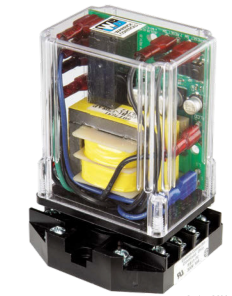Warrick Relay Over Sensing Technical Help
One common issue that can happen with conductivity relays is over sensing the liquid. The below points discuss what may be causing the relay to over sense and remedies to address it.
Over Sensing: When the relay is sensing liquid even when liquid is not present.
- Incorrect Sensitivity selected on controller.
- The Sensitivity selected on the controller should be greater than or equal to the liquid’s conductivity. For example, Natural Water has a sensitivity of 5K Ohms/cm. Therefore, a correct controller’s sensitivity should be the 10K Ohms/cm or the 26K Ohms/cm. Selecting any options higher than this may cause the controller to sense moisture or vapor within the tank, indicating a false indication of water level.
- The Sensitivity selected on the controller should be greater than or equal to the liquid’s conductivity. For example, Natural Water has a sensitivity of 5K Ohms/cm. Therefore, a correct controller’s sensitivity should be the 10K Ohms/cm or the 26K Ohms/cm. Selecting any options higher than this may cause the controller to sense moisture or vapor within the tank, indicating a false indication of water level.
- Liquid or moisture located in conduit or probe fitting:
- Moisture can wick down electrical conduit lines and build up. If the wires are not insulated or are damaged leaving the bare wire exposed, the liquid may bridge the gap between the ground and sensing wire and the controller will see that as liquid on the probes. Also, this same moisture can wick all the way down to the probe fitting enclosure. This will cause the same issue where liquid can build up and thus bridge the gap between the sensing and ground probe. Some solutions to this are to have conduits drain away from the probe fitting, and/or add a dip so it can’t drain up hill. Desiccant packs can also be added to probe fitting enclosures to absorb any moisture. Do not fill the probe fitting with nonconductive silicone as moisture may still become trapped in there and will also make it more difficult to remove the probes for cleaning and replacement. Also make sure the fitting enclosures are properly sealed with the correct gaskets and they are in good shape and not cracked.
- Moisture can wick down electrical conduit lines and build up. If the wires are not insulated or are damaged leaving the bare wire exposed, the liquid may bridge the gap between the ground and sensing wire and the controller will see that as liquid on the probes. Also, this same moisture can wick all the way down to the probe fitting enclosure. This will cause the same issue where liquid can build up and thus bridge the gap between the sensing and ground probe. Some solutions to this are to have conduits drain away from the probe fitting, and/or add a dip so it can’t drain up hill. Desiccant packs can also be added to probe fitting enclosures to absorb any moisture. Do not fill the probe fitting with nonconductive silicone as moisture may still become trapped in there and will also make it more difficult to remove the probes for cleaning and replacement. Also make sure the fitting enclosures are properly sealed with the correct gaskets and they are in good shape and not cracked.
- Probes coming in contact with the ground probe:
- Sometimes long probes may come in contact with each other which would then allow the voltage to conduct through them falsely indicating liquid level. Rigid probes typically should not be longer than 10’, and when they are around 10’ you should use spacers to keep them separated. Another option is to use wire suspended probes as they have plastic protective shields to help prevent contact.

Additional Items to Consider:
- Make sure high voltage wires are not near the relay or probes as it can introduce voltage noise.
- Do not place high voltage wires (120/240 VAC) within the same conduit as the probe wires as it can introduce voltage noise.
- Old style Warrick Relays (like Series 1, 2) cannot be within the same tank as current style relays (Series 16, 26). The old-style relays sent a higher voltage out on the probes and will thus confuse the current style relays.
- Make sure the relay is protected from voltage spikes with a surge protector, as this can damage the relay.
- When using the relay as a single level service for low level alarm, you still connect to the High (H) and G (Reference) terminals on the relay. The relay will look to the (H) probe first so it must always have a probe connected to it.
- Make sure MTW or THHN #14 or #16 AWG wire is used between probes and relay.
- Make sure distance between probes and relay does not exceed distance noted on the Sensitivity Data chart on page E-2. The higher the sensitivity the less distance the wires can be. However, select the sensitivity based on the liquid first. If the distance is too far, consider switching to a lower sensitivity to achieve the longer length, but still maintain a controller sensitivity greater than the liquid.
Please refer to the Instruction Bulletin for wiring diagrams and additional installation instructions.
 SEARCH OUR RESOURCE CENTER
SEARCH OUR RESOURCE CENTER
